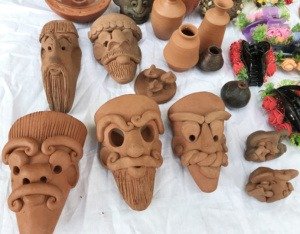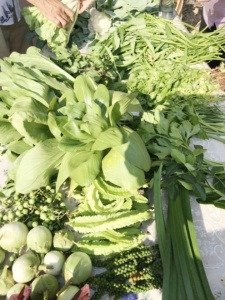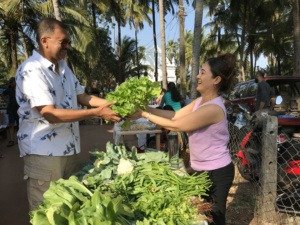
Come Tuesday and all roads lead to the Instituto de Saligao, in the picturesque village, for their weekly market

The ‘Made in Saligao’ market, held every Tuesday, is initiative of the Saligao Institute. Clarice Vaz, a public-spirited Saligaonkar volunteered to take charge of the planning and executing of the market activity. Clarice, a nurse by profession, is also a self trained contemporary abstract artist by calling, a published author (A Song for Saligao) and someone who believes in giving back to society, the idea behind the market was to empower the village people, especially the women, save the ethnic Goan heritage as well as promote local talent. Her passion drove her to make the time and sacrifices for them and it has brought her much joy in return.
One can meet Clarice every Tuesday at the Saligao Institute, where the market is held and be a first hand observer to the way she keeps an eagle eye on the hustle and bustle around her.
Clarice explains how she came up with the idea of a weekly market. “There were these Mahila Mandals around and there were women selling their products. The Mahila Mandals were not a regular feature and only popped up during festivals. So when the management changed here, at the Saligao Institute, I got some pretty good members like Frederick Noronha, Dean D’cruz, Dayanita Singh and I spoke to them about my idea of starting a market here in order to empower women”
Though Frederick Noronha suggested empowering the village of Saligao as a whole, Clarice realized that it was most of the women who came forward when she pitched her idea of a weekly market. After seeing the women step up, men too started coming in and as Clarice says, “It was simply fascinating. Men would drop off their wives and help them set up their stalls and items for sale”.
The market overlooks barriers of caste, creed, religion and every one works together which gives a feeling of accomplishment and joy.
Clarice has maintained strict standards when it comes to the market – how the wares sold and even the presentation. “At the beginning I began by scouting people, visiting their homes, checking their quality and taste of food items. I also needed to know where they live and if they have a permanent address. We started out with 8 people as many were skeptical at first and then slowly the crowd started trickling in, once they felt we started doing well.”
The weekly market commenced in November with around 8 people which then increased to 10 and later jumped to 22. Clarice has a list of rules and regulations in place to ensure that those who secure a stall at the market, adhere to the quality standards. Presentation is also very important as every table has a clean, ironed tablecloth to display the items to be sold.

Clarice later spoke about the recently concluded Christmas season and how it helped to spread word about the market. “Soon it was the Christmas season and around 30 people came to me saying that they wanted to put up their stalls. We set up some of them under the trees and strung up stars that were lit all along the area. We had space for even a barbecue and the community spirit is what kept us going,” Clarice added. She spoke about the generosity of the NRI ‘Saligaonkars’ who would buy food sold at the market and distribute it to the poor, which added to the season of giving.
“When we say ‘Made In Saligao’, it means things not made in any other part of Goa. For example, the pottery sold here is not seen anywhere else. I have visited the house, seen their kiln, and even interacted with the buyers’ families.” She also pointed out that they began having programs at the Institute, like bridge where people would come regularly and it coincided with the market.”
Thanks to the weekly market, many people began getting calls and orders were placed which just proved how successful the market turned out to be. Clarice pointed out that in the kind of set up they have, the barriers were broken, patriarchy was out, and at the end of the day, everyone is a ‘Saligaonkar’.

The group of artisans is an interesting mix of seniors and youngsters with seniors showcasing their traditional skills and youngsters displaying their trendy and modern products. Many of them have their own stories of grit and determination, resilience, strength, overcoming loss as well as giving them a second innings at life after retirement.
Connie Godinho who was resigned to a wheelchair after an accident in 2011, has made her hobby of crocheting into a thriving business. Her crocheted stars were a big hit during Christmas and went on to receive many orders from restaurants as well as Goans living abroad.
Ambrose Vaz, a retired bank manager who suffers from an infection in his leg found his second calling in the art of Macramé – the art of knotting cotton rope without using a needle. It is inspiring to see Ambrose come in every Tuesday with his cane and set up his little stall.
Mary Dias, deep in the pit of grief and despair after the tragic demise of her child, resumed her hobby of knitting and crocheting and finds solace in her work.
Ranjita Salgaokar, a veritable phoenix who literally rose from the flames after a bad burn accident buried herself in her work in the fields as well as making and selling masalas, ‘khotkhote’, ‘ladoos’ and loads of snacks.
Poornima Sakhalkar shows off her terracotta items, Emera Remedios delights everyone with her homemade range of bath soaps and body scrubs, and Sharon Lobo creates impressive showpieces thanks to her art of découpage.
Rainon Fernandes with his ‘Kombucha’, Elaine Nathan from ‘Nathan’s Oven’ with her Belgian chocolate brownies, seed crackers and a variety of muffins and Dew Sivapon Vaz with her organically grown ‘farm to the market’ Thai vegetables, contribute to the exotic ambience of the market.
Clarice has even added a touch of whimsy to the market by having a live ‘Kombbo’ (rooster) on sale along with puppies for adoption. She plans on having a cow next and have farm fresh milk available.
Dayanita Singh, a photographer of repute, a committee member and a long time resident of Saligao, runs ‘precious Pages’ for the market, which sells a wide variety of books for throwaway prices. Guitar classes every Tuesday evening also bring in the crowds along with a bridge session at the Institute.
 Clarice has spread word about her market through Social media, especially the Facebook page called ‘Made in Saligao’ which has garnered loads of likes and has contributed in spreading the word of the market around.
Clarice has spread word about her market through Social media, especially the Facebook page called ‘Made in Saligao’ which has garnered loads of likes and has contributed in spreading the word of the market around.
Many other villages like Moira, Aldona and Salvador do Mundo approached Clarice in order to learn about how she started off and have something similar in their villages. But Clarice points out that one needs a resource person in the village and the personal connect is very important.
Clarice mentioned that the market would be on till the end of March and in April, workshops would be conducted at the Institute, by these artisans to teach others how to make their products. The market will then be closed till November as it is held outdoors and the rains and heat in the month of May doesn’t help the vendors or buyers, so they take a break. Clarice hopefully adds, “If the rains subside early, we will begin in October itself”.
Clarice praises her village and its inhabitants to the high heavens. “It’s a community project and in case of any eventuality, we just have to blow one whistle and everyone is falling over their heels to help one another”.
“It’s like feeding the Five Thousand” A biblical reference to Christ’s Sermon on the Mount after which he fed five thousand people with bread and fish. “It’s very satisfying and gives me a feeling of fulfillment.” she says beamingly.
Clarice stresses on the importance of maintaining the simplicity of life as well as evolving with the times. “We are losing our ethnicity as a diaspora. If we can form a connect with Goans abroad and their village, through social media we will consider it as ‘Mission Successful’





